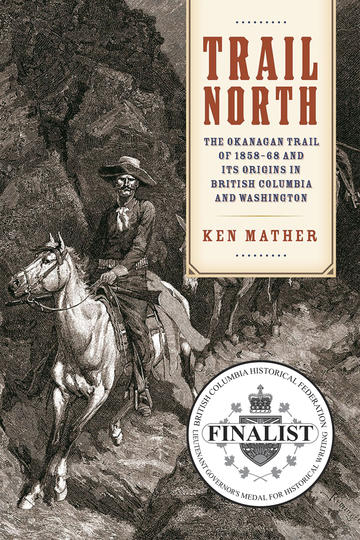Winner (second prize), 2019 British Columbia Lieutenant Governor's Medal for Historical Writing
A revealing history of the ancient trail that served as a major transportation route between Washington and British Columbia and shaped the cultural and economic ties between the two jurisdictions.
Trails are the most enduring memorials of human occupation. Long before stone monuments were created, pathways throughout the world were being worn into hardness by human feet. Travellers along the stretch of Highway 97 from Brewster, Washington, to Kamloops, BC, may not know that they are travelling a route as old as humankind’s presence in the region. In fact, this north–south valley, a natural corridor linking the two major river systems that drain the Interior Plateau, has served as transportation route for tens of thousands of years.
Trail North traces the origins of this iconic trail among the Indigenous people of the Interior Plateau and its uses by the three different fur trading companies, before turning its focus on the period of 1858 to 1868, when the trail was used by miners, packers, and cattlemen as the major entry point into British Columbia from Washington Territory. The historical use of the trail in both jurisdictions is a fascinating episode in the history of the Pacific Northwest.
"I knew a little of the history of this region; I now know a lot more, thanks to Ken Mather’s incredibly well-researched, well-written book, which had me riveted from start to finish. Fascinating stories and details in every chapter. Will appeal to history buffs.
—Roger Knox, Vernon Morning Star
"[Trail North] is an impressive achievement that brings to light an important and, until now, obscure aspect of British Columbia history. It could easily find a place in undergraduate courses on British Columbia history and on the bookshelves of those interested in this period or ranching in British Columbia and Washington."
[T]he author provides an example of the influence of geography on economic development and settlement patterns. The vivid narration brings to life the fortitude of the men and women who travelled this trail. This resource is also useful for comparing past and present practices in resource management, specifically the cattle industry. There are also chapters devoted to the Indigenous People of the Interior which will assist inquiry into the historical legacy of the issues facing these communities today.
Altogether, Trail North sheds new and important light on 19th century British Columbia history. Ken Mather presents an amazing story of a trail that brought European civilization to the Interior and simultaneously created it as a wild space for blowing off pressures from inadequate systems of development elsewhere — while pushing people into narrowly-constrained roles. Mather’s is a hard story that portrays very real pressures.



